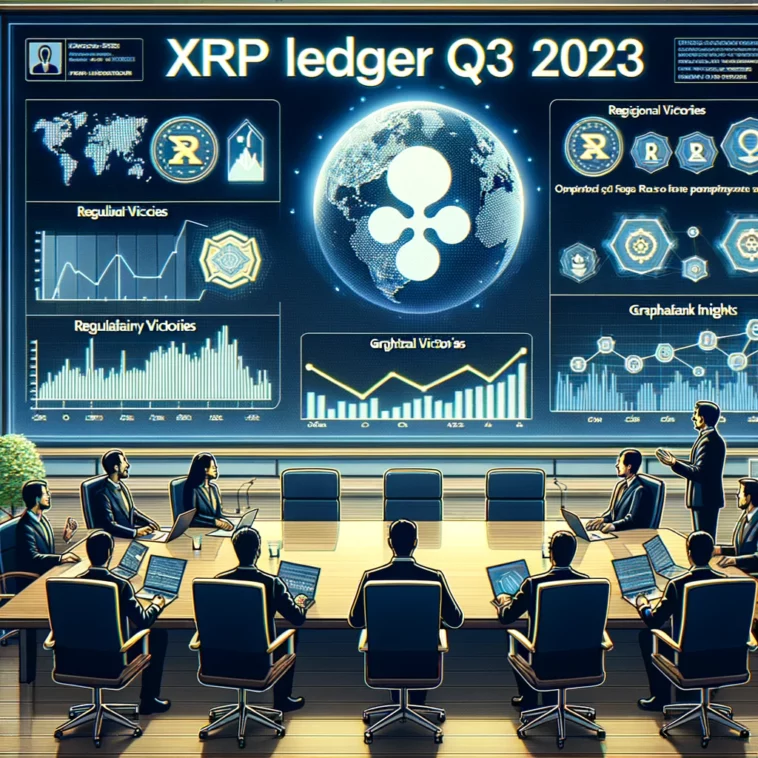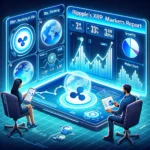The XRP Ledger (XRPL) continues to make strides in the cryptocurrency landscape, with the Q3 2023 report shedding light on its performance and growth. This report provides valuable insights into regulatory developments, financial analysis, and network activity metrics, showcasing the resilience and potential of XRP.
Key Insights:
- Regulatory Clarity: The landmark ruling in July reaffirmed that XRP is not classified as a security, setting it apart from many other blockchain assets. This distinction led to significant market reactions and the relisting of XRP on major cryptocurrency exchanges.
- Market Cap Growth: XRP's market capitalization showed remarkable resilience, ending the quarter with an 11.9% increase compared to the previous quarter and a substantial 59.9% year-to-date growth. Positive regulatory news played a significant role in driving these spikes.
- DEX Volume Surge: Decentralized Exchange (DEX) volume experienced a staggering 390% quarter-on-quarter increase, coinciding with positive regulatory developments. The XRPL's DEX has become a hub for cryptocurrency trading.
- Innovative Solutions: Hooks, a programmability solution, is live on the devnet and heading towards integration with the Xahau Network. Xahau, built on Hooks, introduced its whitepaper in Q3, further expanding the XRPL's capabilities.
- Amendments and Bridges: The XRPL community proposed amendments for an Automated Market Maker and Clawback on the mainnet. Additionally, development efforts continued on the EVM sidechain and the XLS-38d bridge, enhancing interoperability.
Primer on XRP Ledger:
The XRP Ledger, in existence for over a decade, offers fast and cost-effective cross-currency and cross-border payments. Its core features include Issued Currencies, a decentralized exchange (DEX), escrow functionality, and token management. While it doesn't support smart contracts, it accommodates NFTs, stablecoins, synthetic assets, and more, thanks to programmability solutions like Hooks.
Several development groups and individuals support the XRPL, including Ripple, XRPL Foundation, XRPL Labs, XRPL Commons, and Xumm. Its utility extends beyond individual users, attracting interest from central banks and B2B solutions for digital payments.
Financial Analysis:
In Q3 2023, XRP claimed its position as the fifth-largest cryptocurrency by market capitalization, valued at $27.8 billion. The circulating market cap exhibited a robust 11.9% QoQ increase, erasing previous dips and ending the quarter at levels akin to Q1. The year-to-date growth of 59.9% underscores XRP's resurgence.
Transaction fees on the XRPL are burned, creating deflationary pressure on the total supply of 100 billion XRP. This deflationary mechanism, coupled with Ripple's monthly vesting of 1 billion XRP, is poised to influence supply dynamics as escrowed tokens gradually become liquid.
Unlike some crypto networks, the XRPL doesn't distribute rewards or transaction fees to validators. Instead, validators are incentivized to support network decentralization, emphasizing trust among nodes through unique node lists (UNLs).
The Q3 price surge of XRP, particularly in July, was driven by significant developments in the ongoing SEC case. The court's ruling clarified that XRP itself is not an investment contract, a unique distinction among blockchain assets. Ripple's programmatic sales of XRP on exchanges were not deemed securities violations. Consequently, major cryptocurrency exchanges, including Coinbase and Kraken, reinstated XRP listings.
Network Analysis:
Network activity metrics for XRPL experienced a decline in Q2, mirroring trends seen in other large Layer-1 networks. Average daily transactions dropped 9.1% QoQ, and average daily active addresses decreased by 18.5% QoQ.
However, there was an increase in the number of accounts by approximately 125,000, pushing the total accounts to 4.81 million in Q3. New addresses registered a 14.6% increase to 159,100. The number of deleted addresses significantly decreased, returning to typical levels after an anomalous spike in Q2.
XRPL's unique address system, featuring destination tags, affects daily active addresses, particularly when centralized exchanges utilize them. Active recipients surpassed senders, indicating that network activity surges were driven by large groups of previously inactive recipients, likely orchestrated by exchanges and custody solutions.
OfferCreate transactions, responsible for order submissions on the DEX, dominated transaction types. Trust Lines and TrustSet transactions play vital roles in protecting accounts from unwanted tokens.
Transaction Types and DEX:
The composition of transactions on the XRP Ledger witnessed notable shifts in Q3 2023. The increase in Payment transactions played a pivotal role in altering the transaction landscape, surging by 25.2% QoQ to an average of 226,000 per day. In contrast, other prominent transaction types, including OfferCreates, OfferCancels, and TrustSets, experienced declines of 13.0%, 25.7%, and 6.4% QoQ, respectively. These dynamics resulted in an overall 9.1% decrease in total transactions, averaging 1.06 million per day.
Within the ‘Other' transaction category lies a diverse range of functionalities, encompassing NFTs, escrows, multisigs, setting signer keys, and more. The introduction of standardized NFT transaction types through XLS-20 in October 2022 brought about a sudden spike in transaction dominance. A comprehensive exploration of these transaction types is detailed in the Ecosystem Overview section, reflecting the XRPL's adaptability to evolving blockchain trends.
DEX (Decentralized Exchange):
At the heart of the XRP Ledger lies a built-in central limit order book that handles all token exchanges, including fungible tokens and NFTs. This decentralized exchange (DEX) boasts several advantages, including reduced trust requirements and consolidated liquidity, distinguishing it from smart contract-based alternatives. The majority of transactions flow through the native order book DEX, though multiple gateways or marketplaces facilitate user access while sharing liquidity.
In addition to the existing order book, significant developments are underway for an automated market maker (AMM) on the XRPL, as outlined in the XLS-30 standard. This innovation, included in the rippled V1.12.0 release in September, introduces liquidity pools that algorithmically price assets, offering holders the opportunity to earn trade fees by providing liquidity. However, this approach introduces trading risks, such as impermanent loss. The proposed AMMBid transaction type awaits community approval in a future vote for amendment adoption.
Q3 also saw the launch of XRPL Grants Wave 7, with a primary focus on driving innovation within the DEX ecosystem, fostering a thriving marketplace for digital asset exchange.
Servers and Consensus Mechanism:
The XRPL relies on nodes and validators, collectively referred to as servers, all operating the rippled client software. By the end of Q3, over 64% of nodes had transitioned to the latest version, V1.12.0. The remaining nodes either abstained from voting or deliberately refrained from updating to oppose implemented amendments. The XRPL ecosystem is bolstered by 697 nodes and 125 validators, marking a slight decrease in nodes compared to the previous quarter but a concurrent increase in validators.
Servers within the XRPL ecosystem engage in federated consensus as part of the Proof-of-Association (PoA) consensus mechanism. Unlike typical Proof-of-Stake (PoS) networks, validators on the XRPL do not stake tokens or receive financial rewards. Instead, the system relies on trust relationships among nodes, with each node establishing a unique node list (UNL). The UNLModify transaction type, used to add or remove nodes from a UNL, recorded an average of 2.8 occurrences per day in Q3.
Ecosystem Analysis:
While the XRPL's ecosystem encompasses many features akin to programmable settlement networks like Ethereum, Cardano, and Solana, it currently does not natively support smart contracts at the base layer. This design choice prioritizes maximum security and stability, steering clear of arbitrary smart contracts. Instead, the XRPL integrates native features like a DEX and Issued Currencies into its protocol.
Issued Currencies, often referred to as IOUs, serve as on-chain representations of diverse assets, including currencies, commodities, and units. The total market capitalization of fungible tokens, represented by Issued Currencies, experienced a modest 6.6% QoQ decrease, amounting to $134.9 million. With over 3,300 listed assets on the XRPL, SOLO emerged as the dominant token, accounting for 36% of the total market cap. The top three tokens collectively held a 50.6% market cap share.
Stablecoins and wrapped tokens, notably ETH, BTC, and USD tokens, gained prominence within the XRPL ecosystem. Gatehub and Xumm jointly facilitated the availability of 14 digital assets on the XRPL, reflecting a growing preference for stable and well-established tokens.
The number of Trust Lines established for an Issued Currency closely correlates with the number of token holders, although stablecoins and wrapped tokens tend to exhibit significantly more Trust Lines compared to other assets. This divergence is attributed to users keeping Trust Lines open for rapid responses to network-specific volatility or the inherent characteristics of stable assets.
The introduction of Proposal XLS-39d introduced a clawback function, empowering token issuers with enhanced control and regulatory compliance capabilities.
NFTs:
Incorporated directly into the XRPL's core protocol, NFTs do not necessitate smart contracts for creation or transfers, mirroring the seamless nature of Issued Currencies (native tokens). Standardized by XLS-20 in October 2022, NFTs within the XRPL ecosystem offer an array of benefits, including royalties and anti-spam features. These features serve to ensure compliance with regional regulations and safeguard users from unwanted tokens.
NFT Transactions and Growth:
The XRPL ecosystem experienced a notable uptick in NFT-related activities during Q3 2023. Average daily NFT transactions surged by 7.3% QoQ, totaling 16,700 transactions. Among the various NFT transaction types, NFTokenBurn recorded the most significant growth, soaring by 135.7% QoQ to reach 1,700 transactions. NFTokenMints continued their upward trajectory for the second consecutive quarter, rising by 13.1% in Q3, with a daily average of 6,300 transactions. On the other hand, NFTokenCreateOffer, NFTokenAcceptOffer, and NFTokenCancelOffer transactions experienced declines of 7.0%, 7.4%, and 2.0% QoQ, respectively.
NFTokenMint emerged as a dominant force in Q3, challenging the supremacy of NFTokenCreateOffer. This shift was driven by a substantial increase in mints during September, attributed to collaborative efforts across multiple projects, including identity solution XNS and the XRP Family NFT project.
By the close of Q3, a total of 3.0 million NFTs had been minted using the XLS-20 standard. XPUNKS remained the undisputed leader in NFT sales volume, with an impressive 4.4 million XRP (equivalent to $1.9 million USD) in total sales volume.
Sidechains:
The XRPL ecosystem is actively embracing the concept of sidechains, either in the development phase or recently launched. This strategic approach aligns with the XRPL's vision of maintaining minimal complexity at Layer 1 (L1) while offering enhanced programmability for various general and specialized use cases through sidechains.
Coreum
Coreum (CORE) serves as an enterprise-grade L1 solution, prioritizing interoperability and scalability. Operating a WebAssembly Virtual Machine (WASM VM), Coreum relies on a Bonded Proof-of-Stake (BPoS) consensus mechanism. CORE tokens are utilized for transaction fees, staking, and validator rewards on the Coreum network. Despite a 22% QoQ decline in market capitalization, dropping from $54 million to $42 million, Coreum's circulating supply increased by 4%, reaching 535 million tokens. In Q3, the maximum validator set size expanded from 40 to 48 and later to 56. However, as of the end of Q3, only 48 validator slots were occupied, with the top four validators capable of controlling over 34% of the voting power.
Coreum, developed by the Sologenic team, was designed to address user requirements that couldn't be efficiently accommodated on the XRPL. The initial focus of the network revolves around security tokenization, including tokenized stocks from the New York Stock Exchange (NYSE) and synthetic assets. An upcoming milestone on Coreum's roadmap is the integration of Inter-Blockchain Communication (IBC), providing connectivity to IBC-compatible networks such as Cosmos Hub, Ethereum, and Binance Smart Chain (BSC). Users can already facilitate transfers between Coreum and the XRPL via the non-custodial Sologenic bridge.
EVM Sidechain
Peersyst's Ethereum Virtual Machine (EVM) sidechain proposal introduces a proof of concept to bring smart contracts to the XRPL ecosystem. This initiative aims to grant the XRPL community access to EVM developers and functionalities, with a broad scope for general-purpose applications. The EVM sidechain is constructed on the Cosmos SDK, specifically Ethermint, and establishes connectivity with the XRPL through the XRPL-EVM bridge. The Development Network (Devnet) for this sidechain is live and generates blocks approximately every 3.4 seconds using the Comet BFT Proof of Stake (PoS) consensus mechanism, a variant of Tendermint.
The latest version of Peersyst's EVM sidechain was deployed on Devnet V2 during Q2 2023. Notable additions in this version include support for XRP, IOU, and ERC-20 token transfers via the bridge, Proof-of-Authority consensus, and smart contract verification on the block explorer. The XRPL-EVM bridge, designed in accordance with the XLS-38d bridging standard, allows for the seamless bridging of XRP, IOUs, and ERC-20 tokens between the XRPL mainnet and sidechains. Bishop Fox conducted an audit of the XLS-38d bridging standard during Q3.
Root Network
The Root Network sidechain, driven by Futureverse, introduces a blockchain-based NFT system with a strong emphasis on user experience and the metaverse. In its alpha stage, the Root Network is accompanied by a bridge connecting it to both the XRPL and Ethereum. XRP serves as the default gas token within the Root Network. The protocol is built upon a fork of Substrate and offers support for the Ethereum Virtual Machine (EVM) for smart contract capabilities. The Root Network relies on a delegated Proof-of-Stake (dPoS) consensus mechanism, leveraging the ROOT token. The protocol's roadmap aligns closely with the XRPL ecosystem, intending to integrate the XLS-20 NFT standard, tap into liquidity from the XRPL DEX, and provide users with social recovery, asset management, enhanced wallet flexibility, and a user-friendly Web2 experience through the FuturePass account abstraction solution.
Hooks
Hooks, a pivotal feature facilitating smart contract functionality within XRPL transactions, enables the attachment of conditions and triggers to transactions, akin to scripts on UTXO chains like Bitcoin and Cardano (pre-Alonzo). Hooks became operational on XRPL Labs' public testnet in Q2. In Q3, the Xahau Launch Alliance, composed of Evernode, XRPL Labs, Alloy Networks, and Gatehub, released a whitepaper outlining the Xahau Network, a sidechain powered by Hooks. Xahau, leveraging the capabilities of Hooks, is poised to function as an L2 environment, allowing developers to build decentralized applications (dapps) using general-purpose languages such as C and JavaScript. Evernode, a recipient of XRPL Grants Wave 5, is actively contributing to the Xahau Network, which plans to introduce its native token, XAH, with unique tokenomics.
Hooks unlock several programmed features, including scheduled payments, royalty distributions, and transaction limits, enhancing the XRPL's utility.
Enterprise Solutions
Ripple remains a prominent player in developing technologies that harness the XRPL for institutional and governmental use cases. The company focuses on leveraging XRP and the XRPL to power its On-Demand Liquidity service and Central Bank Digital Currency (CBDC) initiatives.
The XRPL continues to play a pivotal role in CBDC exploration by various governments. Ripple's CBDC platform, built on the same blockchain technology as the XRPL, is actively engaging with more than 20 countries to advance CBDC plans. Recent collaboration efforts include the Central Bank of Colombia partnering with Peersyst and Ripple for CBDC development.
In Q3, Ripple unveiled the six finalists of the Ripple CBDC Innovative program, initiated in Q2. Judges are set to allocate $200,000 in prizes to participants developing CBDC-based products. This marks the program's second year of promoting innovation in the CBDC space.
The XRP Ledger's Q3 2023 report illustrates its resilience, regulatory victories, and potential for growth. With a unique position in the cryptocurrency landscape and ongoing developments, XRP continues to carve out its niche as a fast, cost-effective, and versatile digital asset. As regulatory clarity unfolds and the XRPL ecosystem expands, XRP's journey promises further innovation and adoption.


